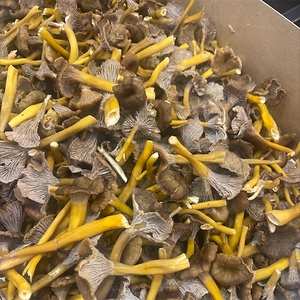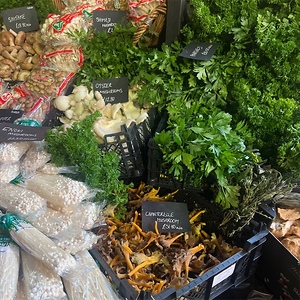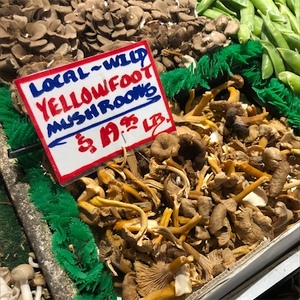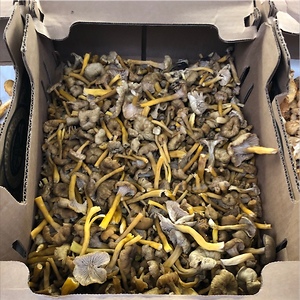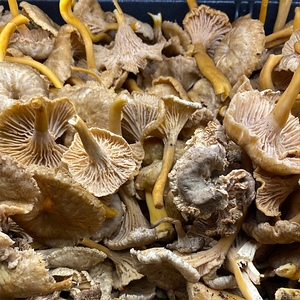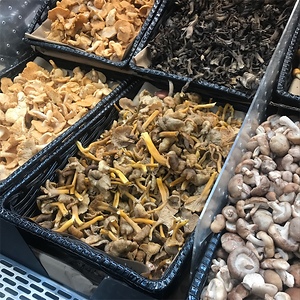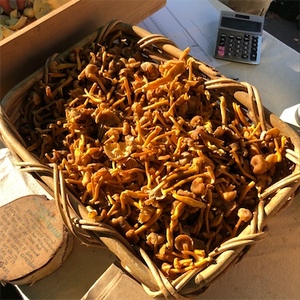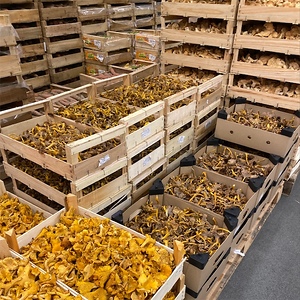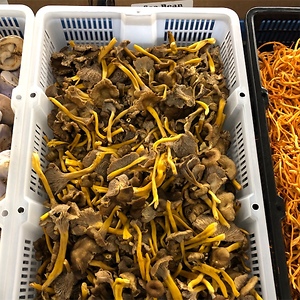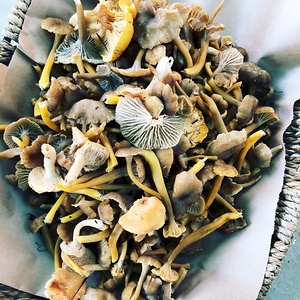

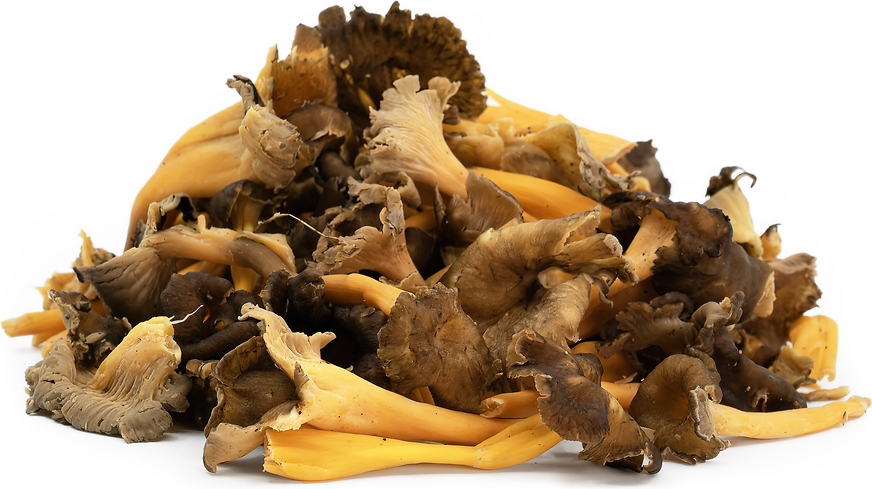
Yellowfoot Chanterelle Mushrooms
Estimated Inventory, lb : 0
This item was last sold on : 08/16/24
Description/Taste
Yellowfoot mushrooms are small in size, averaging 2 to 10 centimeters in length and 1 to 6 centimeters in diameter, and are comprised of a cap and elongated stem. When young, the caps are round and flat, eventually forming into a funnel-like shape with flared, wavy edges. Yellowfoot mushrooms are known for their hollow center, a distinguishing trait of the variety. The caps are delicate, thin, and smooth with a moist, sticky, soft, and waxy feel. The caps also range in variegated orange, yellow, and brown hues. Underneath the cap, false gills extend down to the stem, ranging from straight to wavy, with a shallow, ridged nature. The stems are hollow, thin, elongated, smooth, and taut, exhibiting gold and orange tones. When cooked, the mushrooms develop a tender, slightly chewy, and succulent consistency. Yellowfoot mushrooms emit a subtle, fruity aroma most noticeable when collected in large groupings. The variety is edible once cooked and has a smokey, peppery, earthy, and faintly fruity flavor.
Seasons/Availability
Yellowfoot mushrooms are available in the late summer through early spring, depending on the region. In the Western United States, the variety has a peak season from October through March, while in the Eastern United States, they appear between July and November. In Europe, Yellowfoot mushrooms are in season from August to January, sometimes until February.
Current Facts
Yellowfoot mushrooms, botanically a part of the Craterellus genus, are a late-season, wild species belonging to the Cantharellaceae family. The small, golden-hued mushrooms are a treasured seasonal delicacy among foragers and are a culinary alternative to the popular Golden Chanterelle. Yellowfoot mushrooms are sometimes known as Winter Chanterelles, Funnel Chanterelles, Flame Chanterelles, and Trumpet Chanterelles. Multiple species are categorized under the Yellowfoot name worldwide, and each species is similar in appearance and flavor. The most common species of Yellowfoot mushrooms is Craterellus tubaeformis, and wild populations are present across North America, Europe, and Asia. Yellowfoot mushrooms are easily identifiable and appear in large groupings in the same spots each year. There are also no poisonous look-a-likes, and the small mushrooms are typically brightly colored, making them easy to spot. The fragrant mushrooms are valued for their flavor, texture, and versatility, and chefs and home cooks utilize them in a wide array of sweet and savory preparations.
Nutritional Value
Yellowfoot mushrooms have not been extensively studied for their nutritional properties. Mushrooms are a source of anti-inflammatory properties and vitamins, including vitamins A, C, E, B, and D, which strengthen the immune system, maintain healthy organs, guard the cells against the damage caused by free radicals, and support bones and teeth. Mushrooms also provide nutrients such as potassium, iron, phosphorus, copper, manganese, and fiber. Potassium balances fluid levels, iron develops the protein hemoglobin for oxygen transport through the bloodstream, copper helps the body produce red blood cells, manganese assists in the body making energy, and fiber regulates the digestive tract.
Applications
Yellowfoot mushrooms have an earthy, peppery, and subtly fruity taste suited for fresh and cooked preparations. The variety is known for cooking quickly, and even though it is somewhat delicate, it holds its shape relatively well. It is recommended to gently brush and remove any lingering debris from the mushroom’s surface. Washing is not recommended, as the flesh can take on excess water. If the mushrooms become waterlogged, they should be dried to release the excess moisture before cooking. Yellowfoot mushrooms are popularly dry sauteed and then heated in butter, garlic, oil, or spices as a simple, stand-alone dish. Once cooked, these mushrooms are served with roasted meats, added into casseroles, stuffed into sandwiches, or baked into quiche and tarts. Yellowfoot mushrooms are also diced into ravioli, simmered into risotto, or folded into pasta. Worldwide, Yellowfoot mushrooms are commonly cooked into savory gravies and cream-based sauces. They are also incorporated into soups and stews, cooked into omelets, or used as a pizza topping. Beyond savory preparations, Yellowfoot mushrooms can occasionally be used in sweet dishes such as crème brulee, cheesecakes, carrot cake, poached pears, and ice cream. Yellowfoot mushrooms pair well with meats such as goose, steak, poultry, and wild game, carrots, celery, radicchio, and herbs such as sage, rosemary, tarragon, thyme, and parsley. The variety has a short shelf life and will only keep for 1 to 3 days after harvest. The mushrooms should be stored in a paper bag in the refrigerator. Yellowfoot mushrooms can also be pickled or dried for extended use.
Ethnic/Cultural Info
Yellowfoot mushrooms are often called Winter Chanterelle mushrooms in Europe and are notably used in holiday and seasonal recipes. In Scandinavia, the variety is incorporated in modern interpretations of lefse, a traditional Norwegian flatbread that has become widespread as a regionally significant dish. Lefse is derived from flatbread made by the Vikings, and these types of bread were originally prepared to preserve food sources during the harsh winter season. Historically, Norway was an agrarian society, and it was essential to store the harvests for food during the winter season when few crops could be grown. The flatbreads were dried and rehydrated when needed throughout the winter and were prepared with sweet or savory ingredients. Lefse was considered a comforting meal, and over time, the recipe expanded outside of Norway to other regions within Scandinavia. In the modern day, Yellowfoot mushrooms have become a favored seasonal winter ingredient wrapped into lefse. The mushrooms are combined with sauerkraut to create a savory and tangy meal and are served as a contemporary variation of the classic recipe using locally grown ingredients.
Geography/History
Yellowfoot mushrooms are native to temperate regions across North America, Europe, and Asia and have been growing wild since ancient times. Throughout history, Yellowfoot mushrooms have remained a primarily wild species and thrive in cool climates with ample rainfall. The variety grows on decaying wood and in areas with mossy, wet soil, typically in forests of hardwoods and conifers. Yellowfoot mushrooms form mycorrhizal or symbiotic relationships with the roots of trees, and the species was first recorded by mycologists in 1783. Today, Yellowfoot mushrooms are found throughout North America, Europe, and Asia and are foraged for sale as a culinary variety. In North America, the mushrooms are typically seen in select areas of the Midwest, Northeast, and Pacific Northwest in the United States and Canada. When in season, Yellowfoot mushrooms are foraged from the wild and sold through select farmer’s markets, retailers, and specialty distributors.
Recipe Ideas
Recipes that include Yellowfoot Chanterelle Mushrooms. One
Podcast



